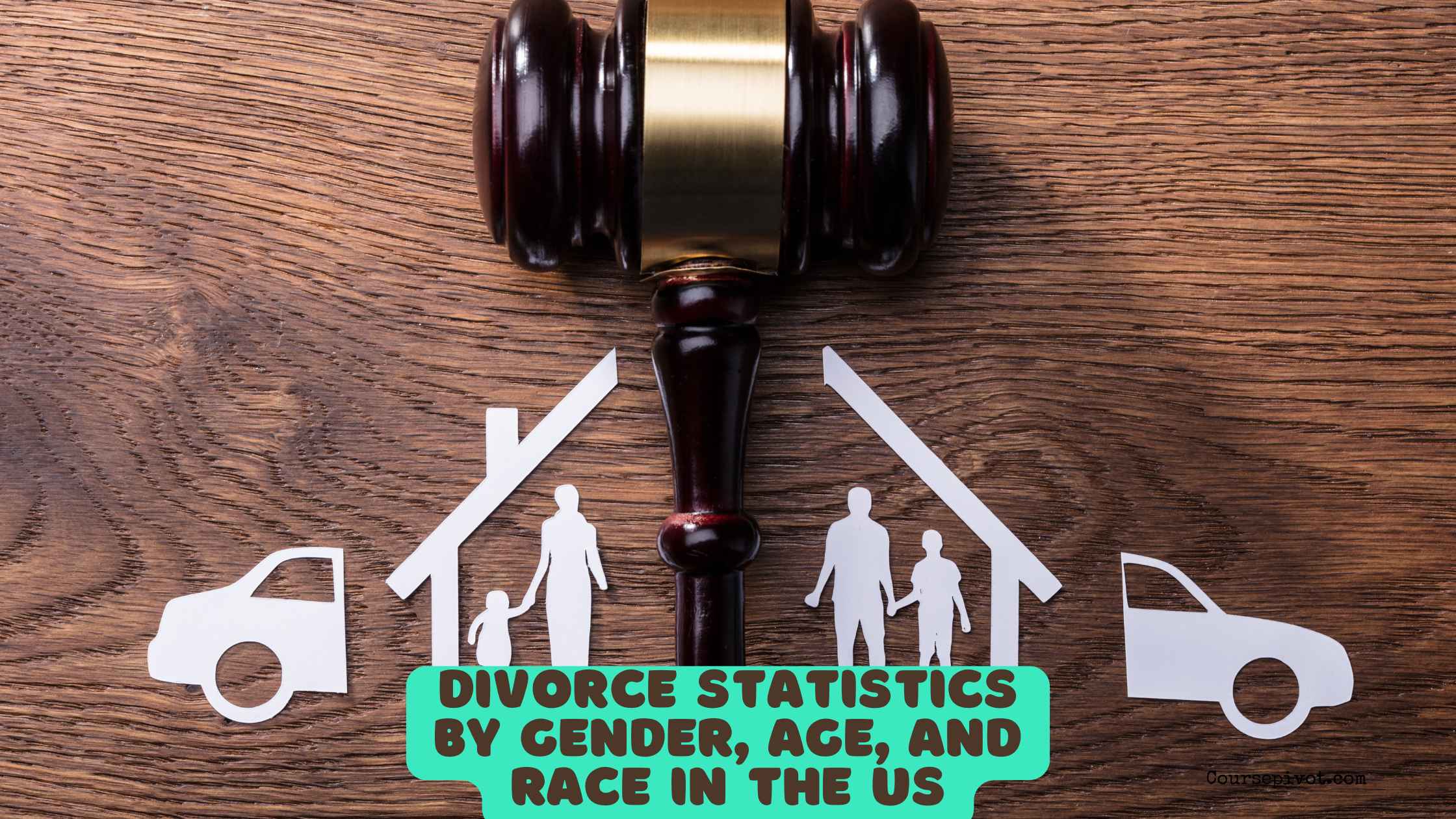
Divorce Statistics by Gender, Age, and Race in the US
The ink on marriage certificates barely dries before some couples face the harsh reality of separation—yet in 2022, the US divorce rate hovered at a modest 2.4 per 1,000 people, down from peaks in the 1980s. This decline masks deeper stories woven through demographics, where divorce statistics by gender, age, and race in the US reveal patterns of resilience, risk, and inequality. As family structures evolve amid economic pressures and shifting norms, these numbers offer a mirror to society’s changing heart.
Table of Contents
This post addresses US divorce rates by demographics, pulling from recent Census Bureau and academic analyses to spotlight 2022 data—the latest comprehensive snapshot—with glimmers into 2023-2024 trends. We’ll unpack who files, when splits peak, and how race shapes outcomes, all while connecting dots to real lives. According to Bowling Green State University’s National Center for Family and Marriage Research (NCFMR), women’s divorce rates have quadrupled since 1900 but stabilized at 14.6 per 1,000 married women in 2022. Why probe these divides? They illuminate paths to stronger unions, turning cold stats into calls for empathy and action.
The Gender Divide: Who Pulls the Plug on Marriage?
Women don’t just endure divorce—they often drive it. In the US, approximately 70% of divorces are initiated by women, a figure holding steady through 2024 per American Sociological Association studies. This isn’t about caprice; surveys link it to unmet emotional needs, unequal household loads, and financial independence—women now out-earning men in 40% of households.
Men, meanwhile, report higher marital satisfaction but face similar dissolution rates overall. The crude divorce rate for both genders sits around 16.9 per 1,000 married women (a proxy for couples), but women aged 15+ saw a 20% drop in rates from 2012-2022, per US Census Bureau visualizations. Picture a mid-career couple in Chicago: She files after years of solo parenting duties, he grapples with the fallout—gender roles still echo in courtrooms.
Yet, nuance tempers the narrative. In college-educated pairs, the initiation gap narrows to 60%, as shared ambitions foster equity. These divorce statistics by gender underscore a truth: Empowerment flips scripts, but lingering imbalances fuel filings.
Age’s Shadow: When Do Marriages Most Often Unravel?
Youth ignites passion but also peril in divorce statistics by gender, age, and race in the US. Couples marrying in their early 20s face a 60% split risk within a decade, per 2024 analyses—far higher than the 25% for those tying the knot after 30. By age 55, 40% of Americans have divorced at least once, with first-timers peaking young.
For women, first divorce rates climb highest in the 15-24 bracket for non-Hispanic Whites (30.8 per 1,000 married) and Asians (12.0), then taper sharply. Older adults buck trends: “Gray divorces” (over 50) rose 21% from 2010-2022, driven by empty nests and longevity, hitting 10.3 per 1,000 in that group.
Consider millennials delaying vows—median marriage age now 30 for men, 28 for women—slashing early splits by 15% since 2000. Yet, economic squeezes like student debt amplify 25-34 risks, where rates hover 20-30 per 1,000 across groups. Age isn’t destiny; it’s a timeline of trials, with maturity often mending fractures.
Racial Ripples: Disparities in Dissolution Rates
Race etches enduring lines in US divorce rates by demographics. Black women lead with 32% of ever-married individuals separated or divorced in 2022—double the 17% for White women—rooted in systemic strains like incarceration disparities. Asians anchor the low end at 10%, buoyed by cultural emphases on family cohesion.
Hispanics clock 21%, multiracial/Other at 23%, per NCFMR’s century-spanning review. First divorce peaks vary: American Indian/Alaska Native women hit 41.6 per 1,000 (ages 25-34), non-Hispanic Blacks 34.0 (35-44), while Asians stay under 12 across ages. In 2024 estimates, African Americans maintain the highest overall rate, followed by Whites at 15.1 per 1,000.
To crystallize these divorce statistics by race, here’s a table of 2022 shares of ever-married women currently separated/divorced:
| Race/Ethnicity | % Separated/Divorced (2022) | Peak First Divorce Rate (per 1,000) |
|---|---|---|
| Non-Hispanic Black | 32% | 34.0 (ages 35-44) |
| Hispanic | 21% | 20.8 (ages 25-34) |
| Other/Multiracial | 23% | 31.8 (ages 25-34) |
| Non-Hispanic White | 17% | 30.8 (ages 15-24) |
| Asian | 10% | 12.0 (ages 15-24) |
| American Indian/Alaska Native | Not specified | 41.6 (ages 25-34) |
Data from NCFMR Family Profiles FP-24-11 and FP-25-06. Real-world echoes? In urban Atlanta, Black couples navigate higher economic volatility, inflating splits; Asian families in California lean on tight-knit networks for stability.
These gaps aren’t innate—they stem from unequal access to counseling or jobs, widening with each policy oversight.
Intersections and Broader Trends: Where Lines Cross
Layering divorce statistics by gender, age, and race in the US exposes intersections: Young Black women (25-34) face compounded risks, with rates 2-3 times White peers, per 2023 extrapolations. Overall, rates dipped 2% in 2023 to 2.3 per 1,000, per CDC provisional data, continuing a post-1980 slide amid later marriages and cohabitation rises.
Education buffers too: College grads divorce 16% less, crossing racial lines. Yet, pandemic aftershocks lingered into 2024, with a 5% filing uptick in high-stress states like California. These threads weave a tapestry of progress—fewer unions overall, but deeper equity chasms.
Building Bridges: Practical Steps to Fortify Your Union
Armed with US divorce rates by demographics, proactive steps can rewrite personal odds. Start with premarital counseling: Programs cut splits 30% for at-risk couples, especially young or multiracial pairs—find free sessions via apps like Lasting.
For gender equity, divvy chores via tools like Fair Play cards; studies show balanced loads slash women’s filing urges by 25%. Age-aware? Delay vows past 25, boosting longevity 20%, and schedule annual “relationship audits” post-50 to preempt gray drifts.
Racially attuned families might join affinity support groups—Black couples in therapy see 15% lower rates, per APA. Track your trajectory with Census dashboards; a yearly check fosters dialogue. These habits? They transform stats from warnings to wisdom.
Key Takeaways
Divorce statistics by gender, age, and race in the US paint a multifaceted portrait: Women initiate 70% of splits, youth (20s-30s) peaks risk at 60%, and Black Americans shoulder 32% separation rates versus Asians’ 10%—all per 2022 NCFMR and Census data. Declines to 2.4 per 1,000 signal societal shifts, yet intersections like young women of color demand targeted support.
Hope thrives in action: Counseling, equity, and delayed commitments narrow gaps, fostering enduring bonds. Ultimately, these figures aren’t fate—they’re invitations to nurture what matters, ensuring more stories end in renewal, not rupture.
Cite this article
You can copy and paste your preferred citation format below.
Martin, L. & Arquette, E.. (2025, October 5). Divorce Statistics by Gender, Age, and Race in the US. Coursepivot.com. https://coursepivot.com/blog/divorce-statistics-by-gender-age-and-race-in-the-us/



